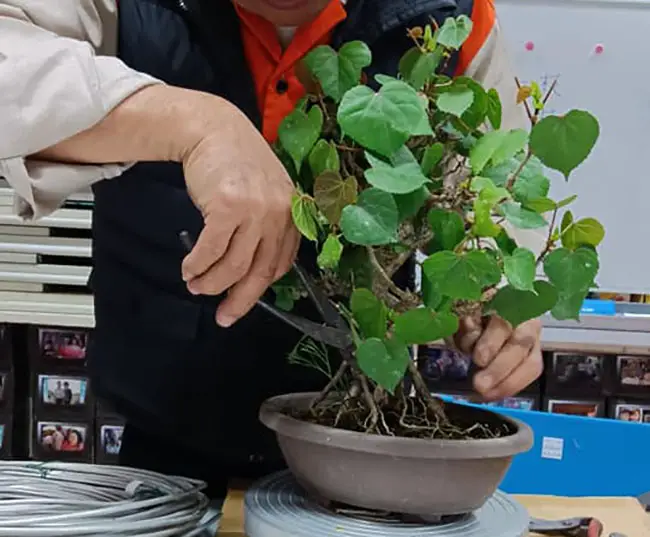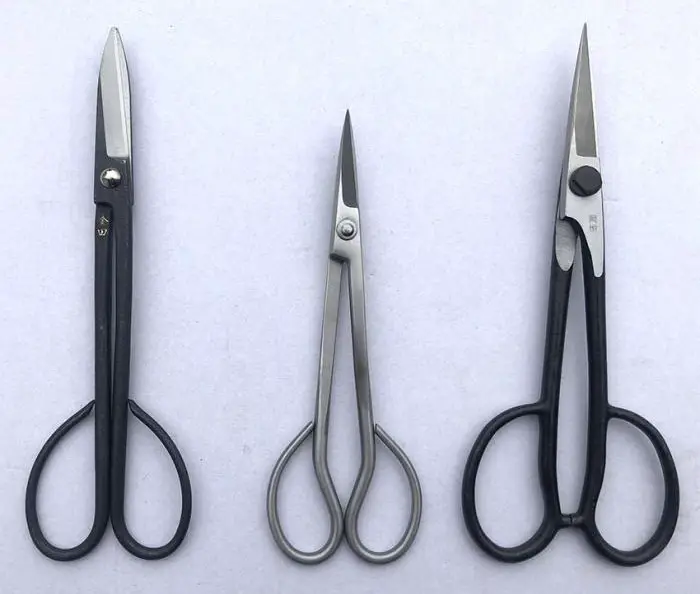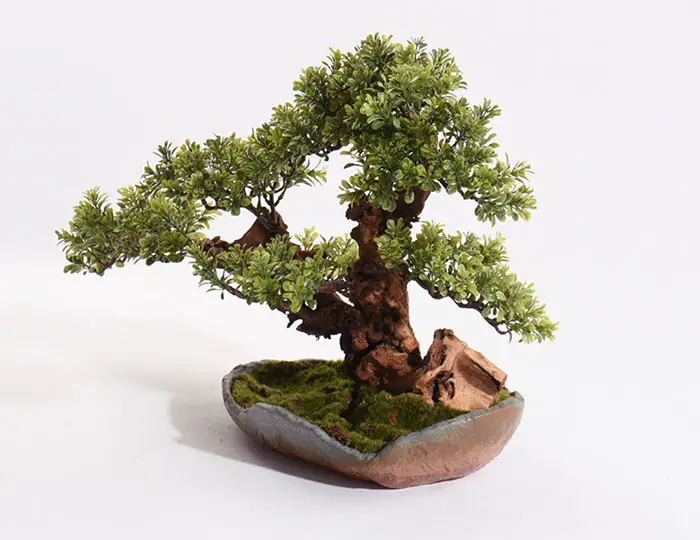The bonsai tree pruning is for styling and shaping it, keeping the shape, breaking an unpleasant and wrong growth bonsai branch, or favoring the buds’ apparition.
Do You Really Need To Trim Your Bonsai Trees?
After a bonsai tree grows to a certain level, it needs to be pruned regularly to maintain its graceful posture. The trimming of bonsai is actually like a barber doing a haircut.
Some of the bonsai branches that grow randomly or age are pruned to make the bonsai more beautiful, layered, and ornamental. After the bonsai is pruned, it will display the artistic conception of the tree. In the pruning process of the bonsai tree, you should only trim the thicker branches and avoid trimming the thinner ones.
Some people pursue the rapid prototyping of bonsai and urgently cut the new branches that have not been lignified. They hope that the side branches will grow in the same year and then be cut again.
They will cut their bonsai tree two or three times within a year and hope that the bonsai can quickly form several levels of branches. However, this can be counterproductive, and you may get a failed bonsai tree instead. So, to avoid anything bad happening to your bonsai caused by improper pruning, we need to learn how to prune the correct way.
What Happens if a Bonsai Is Not Maintained?
A bonsai tree will develop an untidy, unattractive appearance without regular trimming. The branches may start competing for sunlight, leading the tree’s growth in all directions. It’ll become difficult to make out the original form of the tree since the foliage is so dense. As time passes by, weaker limbs can break off due to their weight or be smothered by other branches that are growing on top of them.
Furthermore, without regular pruning, your bonsai tree won’t benefit from good air circulation which encourages healthy new growth and keeps pests at bay. Ultimately, if left untrimmed for too long, your beloved bonsai could die prematurely. Therefore it’s important to keep up with regular maintenance and give your bonsai plenty of love and attention!
Try to Avoid Forcible Pruning
Some people start to prune their bonsai tree when the branches are not lignified. This causes the bonsai cannot to produce side branches. Instead, they sprout from the cut point and continue to grow forward. This makes the bonsai not presentable.
Another thing is that forcible pruning will make your masterpiece fail. If the branches are cut short of forming a holder, the length of the branch holder must be predetermined. It is assumed that the length of the branch holder will not change much after the structure is formed.
However, if the supporting branches are tender, they will continue to grow faster. As a result, the length of several levels of branch support will greatly exceed the predetermined length, which appears to be out of proportion. As a result, the whole bonsai tree will become slender, thin, and irreparable.
Facts have proved that the correct approach is to wait until the branches are lignified and roughly grow to the predetermined thickness before cutting. In this way, the side branches will inevitably form a better angle. To overcome impatience, the branches scheduled to be used as branches must grow to the predetermined thickness.
Generally, they must grow for at least one year. If they are not thick enough, they will grow for another year. After pruning the branches, no new sprouts will appear on the support branch for a long time. Even if it is sprouting, the side branches will not grow vigorously. This is due to a lack of fertilizer.
It is necessary to promote the rapid growth of strong buds and new shoots. Fertilizers should be used appropriately. During the peak growing season, you need to water and fertilize occasionally. By doing so, the side branches will grow steadily.
The best time to prune bonsai is in spring, and “spring prune” is better than “winter prune.” Prune the branches before budding in early spring. At this time, the temperature is milder and more suitable.
In addition, new buds will sprout in a short time. Compared with “winter prune,” “spring prune” is having less harm to the tree. Trees that bloom in spring, such as rhododendrons and plum blossoms, must be pruned after blooming.
Must We Use Scissors To Trim a Bonsai Tree?
Without bonsai scissors, it is difficult to prune a bonsai tree. However, you must understand the right scissors suitable for the tasks and how to use them.
The bonsai scissors are slightly smaller than tree scissors and have a longer front end. It is more convenient to trim small branches of trees. It is mainly used for pruning branches and topping.
Other than bonsai scissors, you may also need other tools to carry out your pruning job:
Wirecutter
Used for trimming and adjusting the shape of the hanging wire. Since pinching the wire at the end of the adjustment will often cause the branches next to it to be injured, it is necessary to cut the wire accurately. At this time, wire scissors are needed.
Pliers
The pliers are used to bend the iron wire in the work of hanging the iron wire. The tools are also needed when the plant is fixed with the iron wire while changing the pot and when the iron wire is loosened.
Bonsai Tweezer
Bonsai tweezer is used in various operations such as removing grass, weeds, and insects. A slightly wider pruning shear is more convenient than a large and sharp tool when removing debris from sea pine.
Sometimes we will need to prune the bonsai tree with bare hands without using any tool. So under what circumstances will we use bare hands for pruning?
Topping
The top buds are often relatively tender. At this time, you can remove them by hand without using scissors. The topping can stimulate the growth of the side buds and help the horizontal growth of the plant. Proper topping can control the height of the plant and grow more luxuriantly.
Buds Trimming
The purpose of bud trimming is to make the nutrients more concentrated so that the plants’ nutrients are more concentrated on the main branches. By doing so, the plants will not grow excessively.
But the timing is often critical. It should be done when the bud is relatively tender. It can also be removed directly by hand.
Shaping The Bonsai Tree
One of the pruning operations and the main one when you decide to shape the bonsai tree is removing the branches for making a design. Don’t forget about the triangle style when you begin to cut, and also keep in mind a design schedule that is for following every spring.
When To Start Shaping Your Bonsai Tree?
Bonsai tree shaping is an art form that calls for precision, dexterity, and in-depth familiarity with the plant’s anatomy. Seeing a bonsai take shape over time is a satisfying process, but you need to know when to start shaping it to get the best results. Timing is everything when creating art. A timely repair can prevent more extensive damage. Starting too early or too late can determine the outcome of your efforts to shape a bonsai tree.
The best time to begin pruning and training a bonsai tree is when new growth appears in springtime. This is typically around March-April depending on where you live, however, this may vary slightly if you are growing indoors as opposed to outdoors. Pruning back branches at this stage helps give shape to your bonsai while ensuring maximum health benefits for the plant. Additionally, it provides room for more delicate foliage which will help bring out its unique character over time.
At this point, you should also consider wiring techniques such as jin (twisted) or shari (deadwood). These techniques allow you to manipulate existing trunks into various shapes while still allowing them freedom of movement — essential for creating life-like forms with realistic curves and twists like those seen in nature. With diligent practice and attention to detail, these methods can yield beautiful results when applied properly!
Just remove the part that you want to ramify or wire back another branch in one or more suitable positions if that particular zone is not covered by the branches, thus cluttering the entire basic design.
Anyway, these procedures have to be done in spring, meaning in the growing season. In a way or another, there are the same pruning tips:
- Cut the branch just above the leaf for favoring the new sprigs sprouting.
- The position that the last leaf is disposed towards, left or right, is the new branch’s ramification direction.
The bonsai leaves are growing at once, with the branches elongating. So, if you want to avoid that, remove the branch just after the new leaves apparition. - In the case of removing the main branches, pay attention to the cutting method. Cut as close as can be to the bonsai trunk and in parallel with it. Then dress the lesion with a lute. Thus bonsai will heal faster.
Bend A Bonsai Tree
The following is to educate yourself on the right techniques for bending a Bonsai tree. Experts and amateurs alike can benefit from the usage of the same set of specialized tools and methods.
The first tool you’ll want to invest in for bending branches is a pair of bonsai branch cutters. These are specially designed clippers with curved blades which help prevent damaging or breaking delicate stems during trimming. They also allow for precise angles when cutting off unwanted twigs and foliage. You may also choose to buy wire specifically made for bonsai trees – these come in varying thicknesses so make sure you select one appropriate for your plant’s size and strength.
To correctly shape your bonsai, gently wrap the wire around the desired part of the trunk or branch after measuring its circumference. Make sure not to tighten too much; slowly increase the pressure until your desired shape has been achieved. The wire should be checked periodically over several weeks as new growth dictates if an adjustment needs to be done. If left on too long or tightened too hard, it could cause scarring or even breakage of the branch.
Keeping Up Bonsai Shape
The specific pruning for keeping up the initial bonsai design is done between the end of the spring and the mid of summer.
What to remove? Make the bonsai pruning when:
- Some branches have a wrong growth, cluttering the initial bonsai design.
- Some leaves are growing too large.
- Too many foliages
- Some juvenile branches are growing a lot too long or over ramifying
Favoring The Sprigs and Buds Sprouting
You can do that in summer when the bonsai tree is developing new buds. Pinch the branch from the point you want it to sprout, and pinch the leaves and buds to encourage back budding and foliage to grow rich.
Conifer Bonsai Pruning
There is no pruning for conifer bonsai but pinching. If the conifer bonsai branch remains without needles, it will die. This thing never happens to the other bonsai tree species, deciduous ones, increasing the ramification after the cutting. Still, in the case of conifers, the cutting is favoring the apparition of the new buds behind.
Flowering Bonsai Tree Pruning
Don’t prune the flowering bonsai plant in the same way as the green bonsai because of the risk of losing the bonsai flowers. So make the pruning in summer, after the flowering period, when you can distinguish the floral buds and the new sprigs.
Trimming your bonsai doesn’t have to be intimidating; with time and dedication, anyone can learn how! Remember: pruning and shaping are essential parts of keeping up a healthy bonsai tree, so make sure to give yourself regular attention and care. And who knows – maybe one day you’ll even become an expert at creating these miniature works of art yourself!



